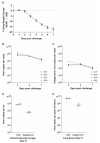Propagation of SARS-CoV-2 in Calu-3 Cells to Eliminate Mutations in the Furin Cleavage Site of Spike
- PMID: 34960703
- PMCID: PMC8704555
- DOI: 10.3390/v13122434
Propagation of SARS-CoV-2 in Calu-3 Cells to Eliminate Mutations in the Furin Cleavage Site of Spike
Abstract
SARS-CoV-2 pathogenesis, vaccine, and therapeutic studies rely on the use of animals challenged with highly pathogenic virus stocks produced in cell cultures. Ideally, these virus stocks should be genetically and functionally similar to the original clinical isolate, retaining wild-type properties to be reliably used in animal model studies. It is well-established that SARS-CoV-2 isolates serially passaged on Vero cell lines accumulate mutations and deletions in the furin cleavage site; however, these can be eliminated when passaged on Calu-3 lung epithelial cell lines, as presented in this study. As numerous stocks of SARS-CoV-2 variants of concern are being grown in cell cultures with the intent for use in animal models, it is essential that propagation methods generate virus stocks that are pathogenic in vivo. Here, we found that the propagation of a B.1.351 SARS-CoV-2 stock on Calu-3 cells eliminated viruses that previously accumulated mutations in the furin cleavage site. Notably, there were alternative variants that accumulated at the same nucleotide positions in virus populations grown on Calu-3 cells at multiple independent facilities. When a Calu-3-derived B.1.351 virus stock was used to infect hamsters, the virus remained pathogenic and the Calu-3-specific variants persisted in the population. These results suggest that Calu-3-derived virus stocks are pathogenic but care should still be taken to evaluate virus stocks for newly arising mutations during propagation.
Keywords: Calu-3; SARS-CoV-2; polymorphisms; stock preparation.
Conflict of interest statement
The authors declare no conflict of interest.
Figures


Similar articles
-
Rapid SARS-CoV-2 Adaptation to Available Cellular Proteases.J Virol. 2022 Mar 9;96(5):e0218621. doi: 10.1128/jvi.02186-21. Epub 2022 Jan 12. J Virol. 2022. PMID: 35019723 Free PMC article.
-
Natural and Recombinant SARS-CoV-2 Isolates Rapidly Evolve In Vitro to Higher Infectivity through More Efficient Binding to Heparan Sulfate and Reduced S1/S2 Cleavage.J Virol. 2021 Oct 13;95(21):e0135721. doi: 10.1128/JVI.01357-21. Epub 2021 Aug 18. J Virol. 2021. PMID: 34406867 Free PMC article.
-
SARS-CoV-2 Bearing a Mutation at the S1/S2 Cleavage Site Exhibits Attenuated Virulence and Confers Protective Immunity.mBio. 2021 Aug 31;12(4):e0141521. doi: 10.1128/mBio.01415-21. Epub 2021 Aug 24. mBio. 2021. PMID: 34425707 Free PMC article.
-
The Emergence of the Spike Furin Cleavage Site in SARS-CoV-2.Mol Biol Evol. 2022 Jan 7;39(1):msab327. doi: 10.1093/molbev/msab327. Mol Biol Evol. 2022. PMID: 34788836 Free PMC article. Review.
-
Experimental Models for SARS-CoV-2 Infection.Mol Cells. 2021 Jun 30;44(6):377-383. doi: 10.14348/molcells.2021.0094. Mol Cells. 2021. PMID: 34187969 Free PMC article. Review.
Cited by
-
A Deletion Encompassing the Furin Cleavage Site in the Spike Encoding Gene Does Not Alter SARS-CoV-2 Replication in Lung Tissues of Mink and Neutralization by Convalescent Human Serum Samples.Pathogens. 2022 Oct 6;11(10):1152. doi: 10.3390/pathogens11101152. Pathogens. 2022. PMID: 36297209 Free PMC article.
-
Generation of quality-controlled SARS-CoV-2 variant stocks.Nat Protoc. 2023 Dec;18(12):3821-3855. doi: 10.1038/s41596-023-00897-6. Epub 2023 Oct 13. Nat Protoc. 2023. PMID: 37833423 Review.
-
Transcriptional Profiling of SARS-CoV-2-Infected Calu-3 Cells Reveals Immune-Related Signaling Pathways.Pathogens. 2023 Nov 20;12(11):1373. doi: 10.3390/pathogens12111373. Pathogens. 2023. PMID: 38003837 Free PMC article.
-
Systematic Exploration of SARS-CoV-2 Adaptation to Vero E6, Vero E6/TMPRSS2, and Calu-3 Cells.Genome Biol Evol. 2023 Apr 6;15(4):evad035. doi: 10.1093/gbe/evad035. Genome Biol Evol. 2023. PMID: 36852863 Free PMC article.
-
Apalutamide Prevents SARS-CoV-2 Infection in Lung Epithelial Cells and in Human Nasal Epithelial Cells.Int J Mol Sci. 2023 Feb 7;24(4):3288. doi: 10.3390/ijms24043288. Int J Mol Sci. 2023. PMID: 36834705 Free PMC article.
References
-
- Pouwels K.B., Pritchard E., Matthews P.C., Stoesser N., Eyre D.W., Vihta K.D., House T., Hay J., Bell J.I., Newton J.N., et al. Effect of Delta variant on viral burden and vaccine effectiveness against new SARS-CoV-2 infections in the UK. Nat. Med. 2021 doi: 10.1038/s41591-021-01548-7. - DOI - PMC - PubMed
Publication types
MeSH terms
Substances
Supplementary concepts
Grants and funding
LinkOut - more resources
Full Text Sources
Research Materials
Miscellaneous

